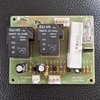needhelpplease
New Member
Hi all,
Very new to electronics. I am having a problem with the auto wire feed on my welder, I noticed the wire feed control panel has a rusty transistor ? Could this stop my controler from working and could I test it in situ on the board. If so, how please.
Thanks
Very new to electronics. I am having a problem with the auto wire feed on my welder, I noticed the wire feed control panel has a rusty transistor ? Could this stop my controler from working and could I test it in situ on the board. If so, how please.
Thanks




